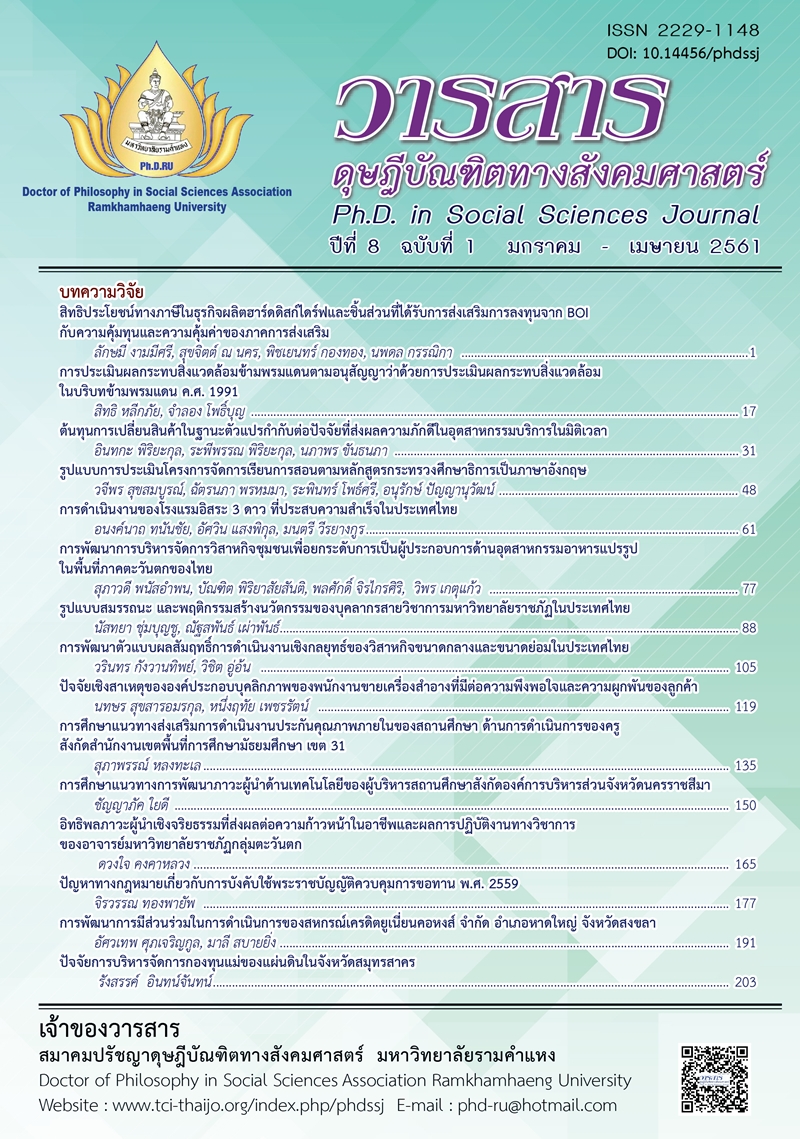FACTOR OF HER MAJESTY’S FUND MANAGEMENT IN SAMUT SAKHON PROVINCE
Main Article Content
Abstract
The objectives of this research were (1) to study the factor of Her Majesty’s Fund management in Samut Sakhon province, and (2) to recommend the initial approach of Her Majesty’s Fund community in Samut Sakhon province. This study was mixed-method research, which collected data from (1) the experienced persons who were in charge of Her Majesty’s Fund in the policy level, for the qualitative data by in-depth interview, and (2) the practitioners of Her Majesty’s Fund in the area level, for the qualitative data by in-depth interview and the quantitative data by questionnaire.
The results of the study can be concluded as follows:
1. The overall average of the factor of Her Majesty’s Fund management in Samut Sakhon province according to the 7’s management concept was high; with the Shared Values was the highest average issue. The other lower average issues can be ordered consecutively as follows: Style, Staff, Skill, Structure, System, and the lowest average issue was the Strategy. The qualitative study that is corresponding to the Shared Values issue, found that the leaders, committees and members of Her Majesty’s Fund have a belief and ideology of Her Majesty’s Fund principle in common. Moreover, it has an encouragement about the good behavior of the committee for being an ideal in community, and also making collaboration of people for responding the kindness of Her Majesty’s wish to solve the drugs problem in community.
2. The initial of Her Majesty’s Fund communities in Samut Sakhon province, were as follows: (1) community’s learning centers of Her Majesty’s Fund establishment (2) dissemination suppression (3) deterrence in the area (4) sharing knowledge to community (5) proficiency development (6) work system improvement (7) public relations (8) work integration to extend an outcome, and (9) Key Performance Indicator (KPI) designation.
Article Details
Academic articles, research articles, and book reviews in the Ph.D. in Social Sciences Journal are author’s opinions, and not the publisher’s, and is not the responsibility of the Ph.D. in Social Sciences Journal Philosophy Association, Ramkhamhaeng University. (In the case that research is done on human, the researcher has to be trained in Ethics for Doing Research on Human Training and has to produce the evidence of the training).
References
Bass, B. M., & Riggio, R. E. (2006). Transformational leadership. Mahwah, NJ: Lawrence Erlbaum Associates.
Certo, S. C. (2000). Modern management. Upper Saddle River, NJ: Prentice Hall.
Community Development Office in Smut Sakhon. (2016). The results of the operation: Fiscal Year 2016. Samut Sakhon: Author. [In Thai]
Injun, S. (2012). Development of innovation management to raise OTOP Handicraft Group, Samut Sakhon province. Siam Academic Review,13(20), 141-154.[In Thai]
LaFasto, F., & Larson, C. (2001). When teams work best: 6,000 team members and leaders tell what it takes to succeed. Thousand Oaks, CA: Sage.
Prime Minister’s Office. (2011). Government Gazette. Retrieved October1, 2015, from www.ratchakitcha.soc.go.th [In Thai]
Trakarnrerk, T. (2015). A management for efficiency development prototype in narcotics abuse prevention and supppression of provincial police region 7. Ph.D. dissertation management, Siam University. [In Thai]
Waterman, Jr., Robert H., Peters, Thomas J., & Julien, R. P. (1980). Structure is not organization. Business Horizons, 23(3), 14-26.
Yamane, T. (1973). Statistics: An introductory analysis. (3rd ed.). New York: Harper & Row.


